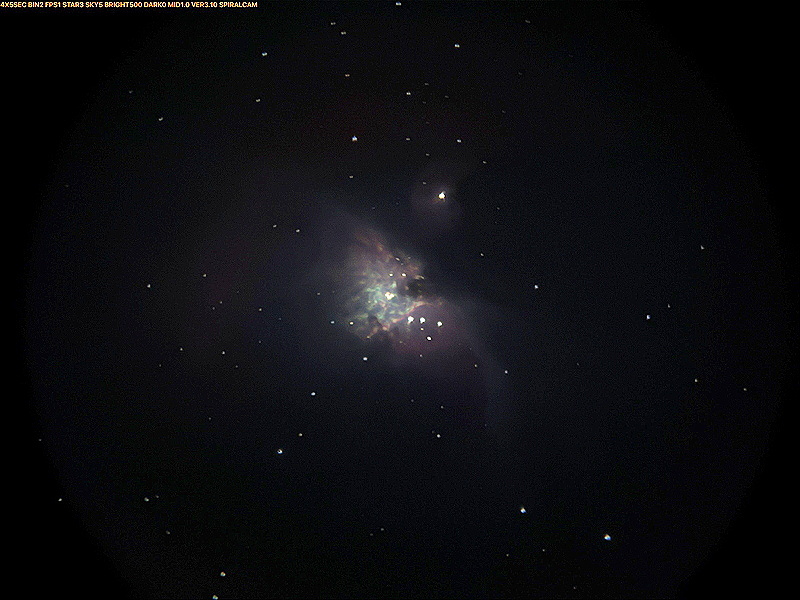Review - SpiralCam, MilkyCam, SaturnCam Astrophotography apps
Posted: 28 April 2020
![]()
![]()
![]()
SpiralCam, MilkyCam, SaturnCam
Yong Chong Loh
Free
The developer of SpiralCam contacted me to let me know about this app for iPhone Deep Sky Astrophotography. The app uses long exposure and automatically does star finding, registration, tracking, and stacking on the iPhone. After testing SpiralCam for awhile I discovered two other apps by the same developer: MilkyCam and SaturnCam. MilkyCam is similar to SpiralCam except its focus is sky astrophotography. SaturnCam is a much needed iPhone app for imaging planets using video and it will stack the video frames on the iPhone.
This review will cover all three apps to provide an overview.
SpiralCam
I was entrigued by the claim of tracking during an exposure, even on altitude/azimuth mounts with no tracking. How well would that work?
The main interface of SpiralCam shows a live view on the left and adjustments sliders on the right. A description of each of the sliders appears if you tap on slider name.


After mounting your iPhone on an eyepiece for afocal imaging, you press start and the app will automatically select stars for tracking. Alternatively, you can select stars manually by tapping on them and then press the start button. After the app starts tracking, you can still select different stars for tracking. To select a star, tap the star on the screen. My first use of the app was on my LX600 tracking mount using the StarLock autoguider. The iPhone 11 Pro Max was mounted on the eyepiece using the Levenkuk adapter. This is an image of the Great Nebula in Orion (M42). The app embeds the settings used at the top, as seen in the blowup. At my suggestion the developer added settings information to the photo EXIF metadata in an app update.

![]()
I also used a 102mm refractor on an alt/az non-tracking mount to image the Orion Nebula, afocal 25X. It was fascinating to watch SpiralCam keep the alignment stars it chose aligned as they drifted across the eyepiece field-of-view (FOV) during this 20 second exposure.

And even more impressive is that when the object drifts too far to the side of the FOV you can Pause the exposure, recenter the object, and then Resume the exposure.
This is an afocal 25X image of the Pleiades star cluster on the 102mm refractor, alt/az, untracked, 30 seconds exposure.

What about a galaxy? Will spiral arms show up in galaxies? I took this StarLock autoguided, afocal 81X, image of M51 (Whirlpool Galaxy), using a Bright setting of 19, Skyglow 0, and a 1 minute exposure.

Although the image has some digital noise, the spiral arms structure is visible.
If you have a tracking mount you can turn off SpiralCam software tracking including star registration and image rotation. This speeds up stacking. To turn off SpiralCam tracking, go Setting > Rotate and drag the slider to 0.
MilkyCam
I mounted the iPhone an eyepiece (81X) on the 12" telescope using the Levenhuk Smartphone Adapter. This is a screen shot showing the adjustment sliders in MilkyCam. The sliders are similar to the adjustment sliders in SpiralCam. You can select the camera to use (three rear cameras or the front camera on the iPhone 11 Pro Max), turn off tripod mounting (if you are handholding the phone), and specify if there is any skyglow by tapping on the text buttons at the top right.

This is a StarLock autoguided, afocal 81X, image of 30 seconds exposure using the default settings.

I then mounted the iPhone on a tabletop tripod using the Levenhuk Smartphone Adapter, seen here.

This is the western sky after dark, with Sirius and the constellation of Orion at the left and the planet Venus at the right. The "Bright" slider was slightly increased and the exposure length was 60 seconds.

I mounted the iPhone piggyback on my tracking telescope and did an ISO 3200, 1 minute exposure of the western sky.

Images from MilkyCam can be exported as TIFF files, allowing for additional editing of a high quality image.
SaturnCam
With the iPhone mounted on the 12" telescope using the Levenhuk adapter, I did some images of the planet Venus. This screen shot shows the adjustment sliders.

Venus, afocal 163X (with a Variable Polarizing Filter to reduce the planet's brightness), ISO 32, 1 minute video recording.

SaturnCam's stacking of video frames on the iPhone worked pretty good.
Summary
Each of these apps can provide useful astrophotography imaging capabilities with an iPhone. The apps can use the Apple Earbuds as a remote shutter release to start and pause imaging. The learning curve, as with all good astrophotography apps, whether on a computer or smartphone, will require some time investment to get the best results. As this is just an overview review, the user is encouraged to explore all the options available in each of the three apps.
The developer has been very responsive to my inputs during my tests of the three apps. I will be doing more imaging with these apps and will post the results on future Cassiopeia Observatory reports.
Comments are welcome using Email. If you are on Twitter you can use the button below to tweet this review to your followers. Thanks.
Cassiopeia Observatory Home Page
Copyright ©2020 Michael L. Weasner / mweasner@me.com
URL = http://www.weasner.com/co/Reviews/2020/SpiralCam/index.html

